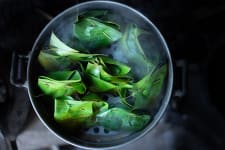The deep, reddish pink of a fresh, wild salmon fillet is so pretty you sometimes forget the glory of what’s on the flipside — namely, savory and robust skin that when cooked right, can be a salmon-eating game-changer. Here’s how to master the art of crispy skin.
ADYF: Always Dry Your Fillets
Moisture is not your friend. Before anything, it’s important to dry the fish well before you place it into the pan to cook. If the skin is still wet, it won’t crisp properly, so using a paper or clean kitchen towel to pat dry the entire fillet is key.
Score the Skin With a Chef’s Knife
You don’t want the skin to curl. It’ll prevent the crisp you’re trying to achieve because not all the skin will cook evenly. But curling is easy to avoid. Just take a knife, and score it in a crosshatch pattern. As an added benefit, whatever seasoning you’re using will slide right past that skin and enter the fillet.
Cast the Right Pan and Oil for the Job
A well-seasoned cast iron skillet works better than a non-stick frying pan, but any kind of skillet will do. Once you have your pan picked out, choose a neutral cooking oil, like grapeseed or canola, which doesn’t break down when you heat it to the high temperature needed to sear the skin-side. Regardless of whether you’re using a gas stove or an electric one, it should be set to high for the searing process; you might want to turn the heat to medium-low as you cook it on the flesh side, to avoid overcooking. When the oil in the pan begins to shimmer, place the salmon fillet, skin-side down into the pan.
Here’s How The Wild Salmon Pans Out
Make sure to apply pressure to the fillet when it’s crisping in the pan. Pressing down lightly on the salmon with a spatula will ensure an evenly cooked skin, and because salmon skin might still even curl while it’s heating up, a little pressure will help to keep the skin flat. Otherwise, you might get stuck with little pockets of skin that are not cooked as well as the rest.
Let the Wild Salmon Be
While on the pan, it’s important that the fillet stays in the same place so it cooks evenly. The fish should only move when you flip it to cook its flesh-side. Approximately two minutes per side per inch of width is a good rule of thumb to ensure that the salmon fillet stays moist and the crispy skin comes out perfectly cooked.






